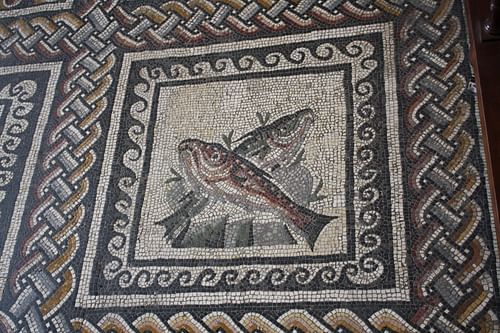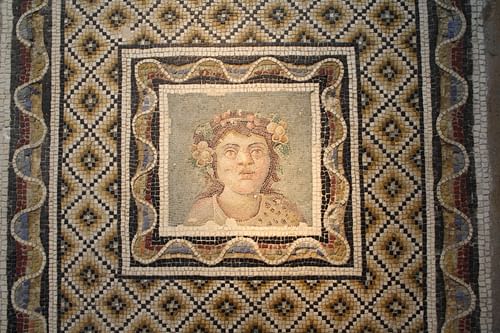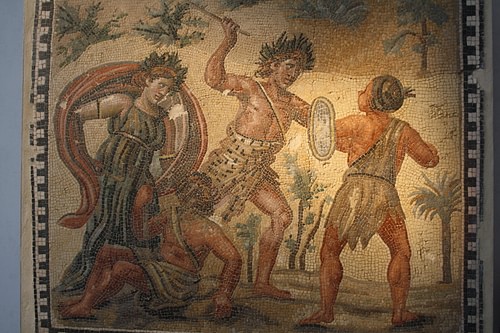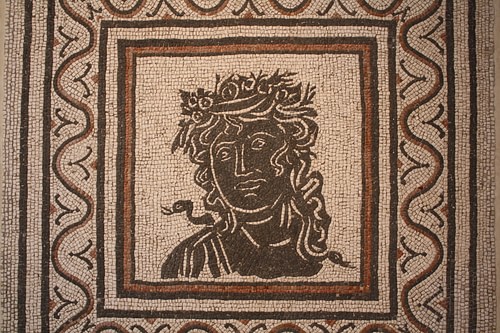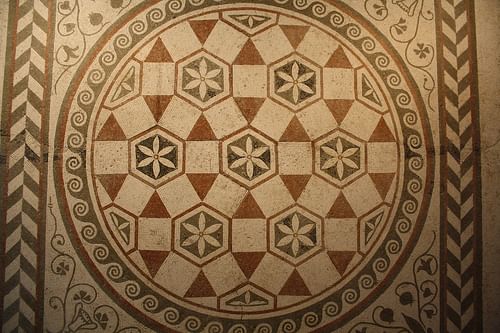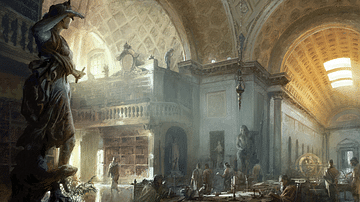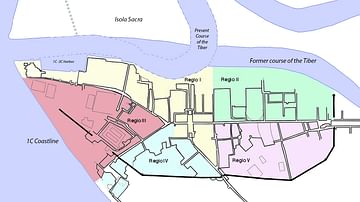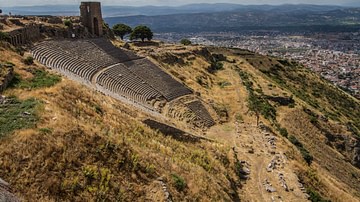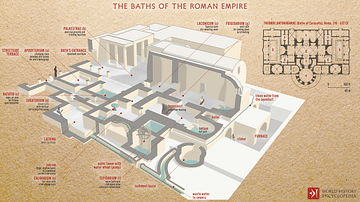Roman mosaics were a common feature of private homes and public buildings across the empire from Africa to Antioch. Not only are mosaics beautiful works of art in themselves but they are also an invaluable record of such everyday items as clothes, food, tools, weapons, flora and fauna. They also reveal much about Roman activities like gladiator contests, sports, agriculture, hunting and sometimes they even capture the Romans themselves in detailed and realistic portraits.
Technique
Mosaics, otherwise known as opus tesellatum, were made with small black, white and coloured squares typically measuring between 0.5 and 1.5 cm but fine details were often rendered using even smaller pieces as little as 1mm in size. These squares (tesserae or tessellae) were cut from materials such as marble, tile, glass, smalto (glass paste), pottery, stone and even shells. A base was first prepared with fresh mortar and the tesserae positioned as close together as possible with any gaps then filled with liquid mortar in a process known as grouting. The whole was then cleaned and polished.
Origins & Influences
Flooring set with small pebbles was used in the Bronze Age in both the Minoan civilization based on Crete and the Mycenaean civilization on mainland Greece. The same idea but reproducing patterns was used in the Near East in the 8th century BCE. In Greece the first pebble flooring which attempted designs dates to the 5th century BCE with examples at Corinth and Olynthus. These were usually in two shades with light geometric designs and simple figures on a dark background. By the end of the 4th century BCE colours were being used and many fine examples have been found at Pella in Macedonia. These mosaics were often reinforced by inlaying strips of terracotta or lead, often used to mark outlines. Indeed, it was not until Hellenistic times in the 3rd century BCE that mosaics really took off as an art form and detailed panels using tesserae rather than pebbles began to be incorporated into patterned floors. Many of these mosaics attempted to copy contemporary wall paintings.
As mosaics evolved in the 2nd century BCE smaller and more precisely cut tesserae were used, sometimes as small as 4 mm or less, and designs employed a wide spectrum of colours with coloured grouting to match surrounding tesserae. This particular type of mosaic which used sophisticated colouring and shading to create an effect similar to a painting is know as opus vermiculatum and one of its greatest craftsmen was Sorus of Pergamon (150-100 BCE) whose work, especially his Drinking Doves mosaic, was much copied for centuries after. Besides Pergamon, outstanding examples of Hellenistic opus vermiculatum have been found at Alexandria and Delos in the Cyclades. Because of the labour involved in producing these pieces they were often small mosaics 40 x 40 cm laid on a marble tray or rimmed tray in a specialist workshop. These pieces were known as emblemata as they were often used as centre-pieces for pavements with more simple designs. So valuable were these works of art that they were often removed for re-use elsewhere and handed down form generation to generation within families. Several emblemata could make up a single mosaic and gradually, emblemata began to resemble more their surroundings when they are then known as panels.
Evolution in Design
With a subject such as mosaics where there are difficulties of dating, tremendous variance in artistic quality, public taste and regional conventions, it is problematic to describe a strictly linear evolution of the art form. However, some major points of change and regional difference can be noted.
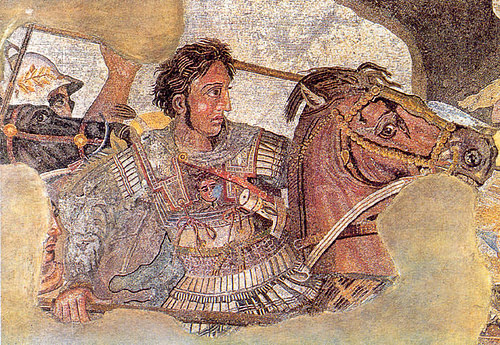
Initially, the Romans did not diverge from the fundamentals of the Hellenistic approach to mosaics and indeed they were heavily influenced in terms of subject matter - sea motifs and scenes from Greek mythology - and the artists themselves, as the many signed Roman mosaics often bear Greek names, evidencing that even in the Roman world mosaic design was still dominated by Greeks. One of the most famous is the Alexander mosaic which was a copy of a Hellenistic original painting by either Philoxenus or Aristeides of Thebes. The mosaic is from the House of the Faun, Pompeii and depicts Alexander the Great riding Bucephalus and facing Darius III on his war chariot at the Battle of Issus (333 BCE).
Roman mosaics often copied earlier coloured ones, however, the Romans did develop their own styles and production schools were developed across the empire which cultivated their own particular preferences - large scale hunting scenes and attempts at perspective in the African provinces, impressionistic vegetation and a foreground observer in the mosaics of Antioch or the European preference for figure panels, for example.
The dominant (but not exclusive) Roman style in Italy itself used only black and white tesserae, a taste which survived well into the 3rd century CE and was most often used to represent marine motifs, especially when used for Roman baths (those from the first floor of the Baths of Caracalla in Rome are an excellent example). There was also a preference for more two-dimensional representations and an emphasis on geometric designs. In c. 115 CE at the Baths of Buticosus in Ostia there is the earliest example of a human figure in mosaic and in the 2nd century CE silhouetted figures became common. Over time the mosaics became ever more realistic in their portrayal of human figures and accurate and detailed portraits become more common. Meanwhile, in the Eastern part of the empire and especially at Antioch, the 4th century CE saw the spread of mosaics which used two-dimensional and repeated motifs to create a 'carpet' effect, a style which would heavily influence later Christian churches and Jewish synagogues.
Other Floor Designs
Floors could also be laid using larger pieces to create designs on a grander scale. Opus signinum flooring used coloured mortar-aggregate (usually red) with white tesserae placed to create broad patterns or even scattered randomly. Crosses using five red tesserae and a central tesserae in black were a very common motif in Italy in the 1st century BCE and continued into the 1st century CE but more typically using only black tiles.
Opus sectile was a second type of flooring which used large coloured stone or marble slabs cut into particular shapes. Opus sectile was another technique of Hellenistic origin but the Romans also expanded the technique to wall decoration. Used in many public buildings, it was not until the 4th century CE that it became more common in private villas and, under Egyptian influence, began to use opaque glass as the primary material.
![Opus Sectile Flooring [Hexagons]](https://www.worldhistory.org/img/r/p/500x600/5535.jpg?v=1667403423)
Other Uses of Mosaic
Mosaics were by no means limited to flooring. Vaults, columns and fountains were often decorated with mosaic (opus musivum), again, especially in baths. The earliest example of this use dates to the mid-1st century BCE in the nymphaeum of the 'Villa of Cicero' at Formiae where chips of marble, pumice and shells were used. In other locations pieces of marble and glass were also added the whole giving the effect of a natural grotto. By the 1st century CE more detailed mosaic panels were also used to embellish Nymphaea and fountains. In Pompeii and Herculanum the technique was also used to cover niches, walls and pediments and once again these murals often imitated original paintings. The walls and vaults of later Imperial Roman baths were also decorated in mosaic using glass which acted as a reflective of the sunlight hitting the pools and created a shimmering effect. The floors of the pools themselves were often set with mosaic as were the floors of mausolea, sometimes even incorporating a portrait of the deceased. Once again, the Roman use of mosaics to decorate wall space and vaults would go on to influence the interior decorators of Christian churches from the 4th century CE.
